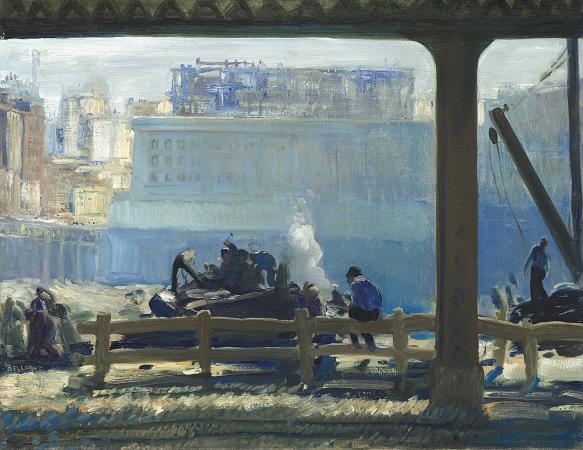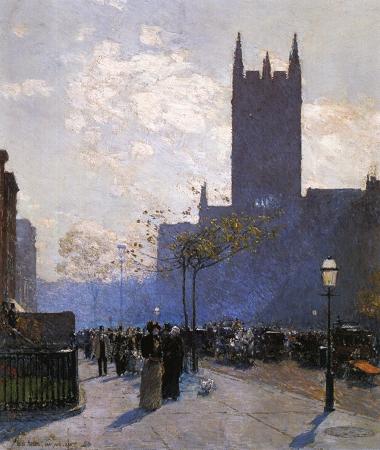Penn Station. Pennsylvania Station is the main intercity railroad station in New York City and the busiest transportation facility in the Western Hemisphere, serving more than 600,000 passengers per weekday as of 2019. The station is located beneath Madison Square Garden in the block bounded by Seventh and Eighth Avenues and 31st and 33rd Streets and in the James A. Farley Building, with additional exits to nearby streets, in Midtown Manhattan. It is close to several popular Manhattan locations, including Herald Square, the Empire State Building, Koreatown, and Macy's Herald Square. Penn Station has 21 tracks fed by seven tunnels, including its two North River Tunnels, four East River Tunnels, and one Empire Connection tunnel. It is at the center of the Northeast Corridor, a passenger rail line that connects New York City with Boston to its north and Philadelphia, Baltimore, and Washington, D.C. to its south, along with various intermediate stations. Intercity trains are operated by Amtrak, which owns the station, while commuter rail services are operated by the Long Island Rail Road and NJ Transit. Connections are available within the complex to the New York City Subway and buses. Penn Station is named for the Pennsylvania Railroad, its builder and original owner, and shares its name with several stations in other cities. The original Pennsylvania Station was an ornate station building designed by McKim, Mead, and White and considered a masterpiece of the Beaux-Arts style. Completed in 1910, it enabled direct rail access to New York City from the south for the first time. Its head house and train shed were torn down in 1963 at a time of low train ridership, with the rail infrastructure reconstituted as the smaller underground station that survives today. The New York Times editorial board described the demolition of the original station as a monumental act of vandalism, and its destruction galvanized the modern historic preservation movement. The 2020s saw the opening of Moynihan Train Hall, an expansion of Penn Station into the Farley Post Office building, as well as expansion of the LIRR concourse and a new direct entrance from 33rd Street to the LIRR concourse. Further plans call for adding railway platforms in a new southern annex to connect to two new Gateway Program tunnels under the Hudson River, adding underground connections to the Herald Square station and with the PATH to the 33rd Street station, and renovating the core Penn Station under Madison Square Garden. Until the early 20th century, the PRR's rail network terminated on the western side of the Hudson River at Exchange Place in Jersey City, New Jersey. Manhattan-bound passengers boarded ferries to cross the Hudson River for the final stretch of their journey. The rival New York Central Railroad's line ran down Manhattan from the north under Park Avenue and terminated at Grand Central Depot at 42nd Street. Many proposals for a cross-Hudson connection were advanced in the late 19th century, but financial panics in the 1870s and 1890s scared off potential investors. In any event, none of the proposals advanced during this time were considered feasible. An early proposal for a bridge was considered but rejected. The alternative was to tunnel under the river, but this was infeasible for steam locomotive use. The development of the electric locomotive at the turn of the 20th century made a tunnel feasible. In 1901, PRR president Alexander Cassatt announced the railroad's plan to enter New York City by tunneling under the Hudson and building a grand station on the West Side of Manhattan south of 34th Street. The station would sit in Manhattan's Tenderloin district, a historical red-light district known for its corruption and prostitution. Beginning in June 1903, the two single-track North River Tunnels were bored from the west under the Hudson River. A second set of four single-track tunnels, the East River Tunnels, were bored from the east under the East River, linking the new station to Queens, the PRR-owned Long Island Rail Road, and Sunnyside Yard in Queens, where trains would be maintained and assembled. Construction was completed on the Hudson River tunnels on October 9, 1906, and on the East River tunnels on March 18, 1908.
more...



